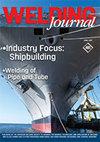焊接金属成分与微观结构和性能相关联的数值模型评述
IF 2.2
3区 材料科学
Q2 METALLURGY & METALLURGICAL ENGINEERING
引用次数: 0
摘要
使用计算工具对焊缝微观结构和特性进行建模或描述的情况一直在稳步增加,这些数据集包含各种输入和实验测量的输出。这些工具的复杂程度从电子表格中简单的双因素相关到人工神经网络不等。本文章由计算机程序翻译,如有差异,请以英文原文为准。
Comments on the Numerical Models for Correlating Weld Metal Composition to Microstructure and Properties
There has been a steady rise in the use of computational tools to model or describe weld microstructure and properties from data sets containing a wide range of inputs and outputs measured by experiments. The tools range in sophistication from simple two-factor correlations in spreadsheets to artificial neural networks.
求助全文
通过发布文献求助,成功后即可免费获取论文全文。
去求助
来源期刊

Welding Journal
工程技术-冶金工程
CiteScore
3.00
自引率
0.00%
发文量
23
审稿时长
3 months
期刊介绍:
The Welding Journal has been published continually since 1922 — an unmatched link to all issues and advancements concerning metal fabrication and construction.
Each month the Welding Journal delivers news of the welding and metal fabricating industry. Stay informed on the latest products, trends, technology and events via in-depth articles, full-color photos and illustrations, and timely, cost-saving advice. Also featured are articles and supplements on related activities, such as testing and inspection, maintenance and repair, design, training, personal safety, and brazing and soldering.
 求助内容:
求助内容: 应助结果提醒方式:
应助结果提醒方式:


